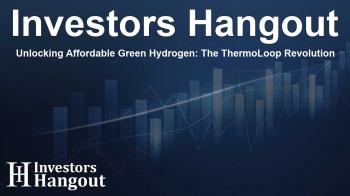Unlocking Affordable Green Hydrogen: The ThermoLoop Revolution

Unlocking Affordable Green Hydrogen with ThermoLoop
Discover how NewHydrogen's ThermoLoop technology utilizes heat and water to produce the most affordable green hydrogen.
NewHydrogen, Inc. (OTCMKTS:NEWH) has made significant strides in green hydrogen production with its innovative ThermoLoop technology. Unlike traditional methods that rely heavily on electricity, ThermoLoop capitalizes on the abundant resources of heat and water to create the world's most economical green hydrogen.
CEO Steve Hill emphasizes the transformative nature of this technology, stating that ThermoLoop represents a fundamental shift away from conventional electrolyzer systems. By offering a drop-in replacement for existing electrolyzers, ThermoLoop has the potential to revolutionize the hydrogen production landscape. Hill believes that, in essence, ThermoLoop will be an "electrolyzer killer," significantly enhancing efficiency.
Understanding the Challenge of Hydrogen Production
The task of efficiently splitting water to extract hydrogen and oxygen has perplexed scientists for decades. The primary issue arises from the conflicting temperature requirements of the reactions involved: the reaction for hydrogen production occurs at lower temperatures, while oxygen extraction demands higher temperatures. This temperature mismatch leads to inefficiencies during ramp-up and down periods, where no hydrogen is being produced, and energy is wasted.
Introducing ThermoLoop: A Game Changer
NewHydrogen has tackled this inefficiency head-on with the development of ThermoLoop, which innovatively allows multiple reactions to occur at nearly identical temperatures. This process, known as thermochemical water-splitting, encourages simultaneous reactions and minimizes downtime, optimizing hydrogen production.
Novel Approaches and AI Integration
Finding the right materials for this process is key. Utilizing state-of-the-art artificial intelligence and machine learning, NewHydrogen investigates various elements and their interactions, assembling a novel material that can attain the ideal "Goldilocks" characteristics necessary for successful isothermal reactions.
Exploring the Secret Behind ThermoLoop
The secret to ThermoLoop lies in its unique set of chemical reactions, which leverage the phase change properties of the new materials. As components transition from solid to liquid to gas, the temperature differences between reactions are diminished, paving the way for continuous production of hydrogen. This tightly integrated process is what NewHydrogen views as the key to achieving efficient, scalable hydrogen production.
Hill remarks on the versatility of ThermoLoop, noting that it can be paired with any source of heat and water, providing an adaptable solution for hydrogen production worldwide. The system is designed to operate efficiently regardless of the source of heat, further enhancing its viability as a sustainable hydrogen production platform.
Efficiency in a New Era of Energy
The economic landscape for green hydrogen is evolving. As traditional methods of electricity generation for hydrogen production remain costly, ThermoLoop offers a path to significantly reduce these expenses. By utilizing direct heat rather than indirect electricity, NewHydrogen aims to fundamentally transform the cost structure of hydrogen production.
In collaboration with top researchers at UC Santa Barbara, NewHydrogen is ushering in a new age for green energy solutions, aiming to meet the future market demand projected to be worth trillions.
Frequently Asked Questions
What is ThermoLoop technology?
ThermoLoop technology is a novel method developed by NewHydrogen that utilizes heat and water to produce green hydrogen, eliminating the need for electricity.
How does ThermoLoop improve hydrogen production?
ThermoLoop minimizes inefficiencies found in traditional methods by allowing simultaneous reactions to occur at similar temperatures, leading to continuous hydrogen production.
Why is heat an advantageous resource for hydrogen production?
Heat is cheaper and more readily available than electricity from renewable sources, making it a more efficient option for hydrogen production.
What implications does ThermoLoop have for the hydrogen economy?
By significantly lowering production costs, ThermoLoop has the potential to accelerate the adoption of green hydrogen and support a more sustainable energy future.
How can I learn more about NewHydrogen?
For additional information, you can reach out via email at ir@newhydrogen.com or visit their official website.
About The Author
Contact Thomas Cooper privately here. Or send an email with ATTN: Thomas Cooper as the subject to contact@investorshangout.com.
About Investors Hangout
Investors Hangout is a leading online stock forum for financial discussion and learning, offering a wide range of free tools and resources. It draws in traders of all levels, who exchange market knowledge, investigate trading tactics, and keep an eye on industry developments in real time. Featuring financial articles, stock message boards, quotes, charts, company profiles, and live news updates. Through cooperative learning and a wealth of informational resources, it helps users from novices creating their first portfolios to experts honing their techniques. Join Investors Hangout today: https://investorshangout.com/
The content of this article is based on factual, publicly available information and does not represent legal, financial, or investment advice. Investors Hangout does not offer financial advice, and the author is not a licensed financial advisor. Consult a qualified advisor before making any financial or investment decisions based on this article. This article should not be considered advice to purchase, sell, or hold any securities or other investments. If any of the material provided here is inaccurate, please contact us for corrections.

